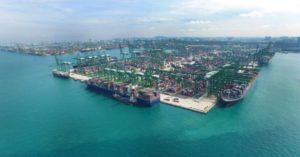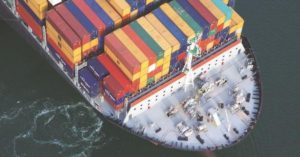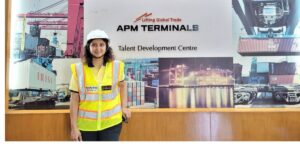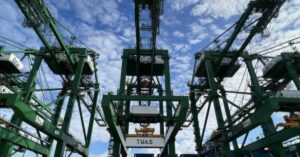Sri Lanka has the potential to be a world-class maritime regional hub. It will take private enterprise, investment and working in collaboration with the public sector to mobilize the vision to reality, and that for this part of the world can be quite challenging at the best of times.
We have seen recently, there were a lot of issues at Colombo, low productivity at terminals causing delays and backlogs in clearances. How is the situation now at Colombo terminals?
The Port of Colombo consists of 3 terminals: CICT, the latest and the only deep draft facility in South Asia, SAGT is the first private terminal that was established in 1999 and of course, Jaya Container Terminal (JCT) which is a government operated terminal. All the 3 terminals, like many in the region and globally did, at the outset of the pandemic, have some disruptions, but I am pleased to say that the 3 terminals working in close operational collaboration have now normalized the port operations in Colombo.
There was also disruption from the liners and some service cancellations and also it has affected the vessel schedules and the planning at the terminal. So, how much of it affected your terminal and how much it has impacted the cargo volumes?
Overall, at year-to-date the Port of Colombo is about 12% down at the end of 2020 versus the previous year 2019, but obviously if you look at the last 6 months perhaps in the second half of the year which is traditionally also a higher uptick in volumes when you compare the full year, the second half of the year is 60% of the full year, we certainly have been much more impacted in terms of the volumes.
You mentioned about void sailings, but there is a whole plethora of factors behind it. Things such as the long dwell of containers in the port was simply because importers could not clear it, Customs and shipping lines are operating unlimited hours, people have not had the contingencies in place to handle the bills of lading, banks are operating unlimited hours, truck drivers could not come because they were typically in lock down areas. So, there is a whole plethora of things. To be fair, the whole industry across the globe responded more swiftly than many people anticipated and I think just looking back to when Indian ports went into lockdown, as you know India is the elephant in the room for the region and for most part of global trade, that certainly sent lot of shockwaves to the system but it seems almost like a distant past now because today we are operating almost back to normal.
What is your future outlook?
So far when we speak to our customers, the shipping lines, many of them themselves don’t seem to have a handle on what might be the future? We are beginning to see a new supply chain in terms of sourcing. I talked about this even last time when I was on the programme where importers are looking for near sourcing and their traditional sourcing, so you might have sourcing from China and then somewhere midway point. We are seeing a lot more cargo or trade between ASEAN block of nations and South Asia mainly India and to some extent Bangladesh. So, these are some of the evolving changes that we have seen. The fact I mentioned about the container dwell time in the ports, purely because importers couldn’t take delivery and so on and so forth, just for SAGT in 2019, the average dwell time for transshipment containers was less than 3 days. In the course of the last quarter of 2020, we were averaging about 14 days. So, this had a severe impact on the yard density, the flexibility of the yard, impacting the vessel productivity on the quay side. These are some elements that nobody could’ve even predicted, going from 3 days average to 14 days. So, that was a swift move that happened just overnight and not gradually. In the meantime cargo was still coming in because the Port of Colombo remained operational right throughout. We never closed the door to say we cannot handle ships. We did have some disruptions for sure, but at no stage did we say, we are not handling ships. So, at times, we couldn’t handle as many ships as we have done in the past but certainly the recovery and the engagement I think was something quite creditable. The Sri Lanka Ports Authority Chairman with his military background, brought in some military precision in terms of the bringing parties together to a common goal – be it the transport companies, the shipping companies, Customs and all other stakeholders together. I am pleased to say that the Port of Colombo is operating back to normal, the inter-terminal trucking is back to normal. Ultimately, these combination of factors, if there is a tip of the balance and you have more containers discharged in one terminal more so than you would normally have, then it changes the pattern of that ITT truck movement. We try to avoid a single truck movement like moving a truck from SAGT to CICT which in turn brings the box back to SAGT. So, those are things that we have identified where we could improve and we continue to do that.
The challenges that you have mentioned which impacted the business at Colombo are due to the pandemic and this is a temporary phenomenon, as things would spring back to normal. But you are a transhipment hub at a very strategic location and we have been hearing talks about Indian government promoting transhipment hubs on Indian coast, one is already there and then couple of more they have been thinking. Of course, there is an intent. I do not know how much of walk the talk the government would do and how much of it is done would get materialized but the intent is there. So, are you worried about these developments and what else Colombo is doing to retain its position as a transhipment hub?
The Port of Colombo’s strategic geographic position alone is no more its competitive advantage. Our customers are looking for end-to-end when the ship comes to the port till it gets out of the port, the optimum operating time which means that the ship that is sailing between ports is actually earning money rather than sitting in the port, so we recognize that. Now, in the South Asia region, CICT in the port of Colombo is the only deep draft facility. So, the three terminals in the port of Colombo are complementary to each other because each has its unique value proposition. When we talk about competition, we consider Jebel Ali to our west and to our east is Singapore and Tanjung Pelepas to some extent in Malaysia. So, these are the hub ports for competition. We see the port of Colombo actually as an extension, if you would like complementary, to India’s import, export community. If you really think about as you quite rightly mentioned, 70% to 80% of our throughput is transhipment of which India alone represents about 75% to 85%. We want India as partners with us as we also need to position ourselves and I think there is some work to be done to win the confidence of Indian importers and exporters. We have done many visits to India promoting what we do in the Port of Colombo, doing roadshows, presenting the value proposition of how Sri Lanka or Port of Colombo can be complementary.
Now, this is not to say that you don’t need to have direct services going to the Indian ports. This is in addition to those. You can have a fast ship, a slow ship and on many occasions the transhipment vessel arrives at destination faster than the direct vessel. So, I think it’s having options available to the end customer and in that regard, I think Port of Colombo continues to have some important value proposition to the South Asia partners. For India, Pakistan and even Bangladesh it makes sense to relay cargo out of Colombo if you are going towards Europe or to the East Coast of USA. There would be some discussion or debate saying that it might be faster to go from Bay of Bengal over Singapore, Malaysia if you want to go to west coast of the USA, but it all depends on where the shipping lines have their networks also. What we are doing is focusing on that key deliverable which is turning that vessel around not just on the key side but from the time she gets into Port of Colombo waters till she departs and that includes the tugs, pilots and all of those other ancillary services that are very integral to the terminal performance also.
Apart from India being a major partner in business, even Bangladesh is also another important partner for you. So, what is the update from Bangladesh?
I think Bangladesh has not surprised too many people in terms of their growth. We have always known that Bangladesh had some challenges in terms of the infrastructure, ships getting in and out. There is some development in regards to the River Mouth terminal that’s getting underway. So, certainly Sri Lanka again will position itself as the gateway to South Asia; that’s not to say that the others are not important. I think they are complementary but we are so much closer to the East West main trade routes. So, our position to Bangladesh particularly with all that garment cargo that comes in, now we know that at various times and over the past years, you might see some congestion in Chittagong, some challenges in Colombo, Nhava Sheva and so on and so forth. These are not unusual, but it is how quickly each of those facilities can respond swiftly to the challenges at hand and I think the whole region has done a remarkable job where after the initial onslaught and the second wave, that we are at each turn improving in the way we actually respond to these challenges and keep the business moving reasonably, seamlessly.
I see from the media reports that your Shipping Minister and Sri Lankan Ports Authority Chairman talk a lot about bringing lot of focus on port development in Colombo. So, what actually is the intent of the government in terms of developing or improving Colombo as a hub?
Quite often people look at the hub concept as simply moving containers around but I think when we talk about a maritime hub, you are talking a lot much more than just container movement. So, as I mentioned, we are in a good strategic location. I would like to see us develop international flow centre where you can bring partially completed goods and finish them off in Port of Colombo within the customs-controlled area and then re-ship them out. So, this is re-shipping of transit for re-export. We would like to see a greater capability of equipment repair and ship maintenance so that you can do this. You don’t have to go into dry dock, we have those capabilities around. Maritime arbitration, Singapore has done a wonderful job in that regard is to get maritime arbitration, all of these factors, I think, contribute to positioning a location as being effective maritime hub. So, we are not just a transhipment hub, I would like and that’s what has been the political rhetoric also is that we want to position ourselves as a maritime hub. The minister’s vision that he has set is the aspirations of where he want to be. It will now take private enterprise an investment and appetite, working in collaboration with the public sector to motivate and to mobilize the vision to reality, and that for this part of the world can be quite challenging at the best of times. It takes time, but I think all parties, all stakeholders are one voice that whether it be ECT, we are already 4 years too late, and there’s so much other stuff that can be done but I think equally we can’t all point the finger at government and say what are you doing about it? Government’s job is to facilitate, to put the regulations in place that will be conducive for private enterprise to come in and invest. So, I think the government is doing that now and unfortunately Sri Lanka, you know, the last few years, we had a number of political upheavals, change of government, change of policies and so on. So, I think now we are beginning to see some traction. The potential to be a world-class maritime regional hub has never been in doubt. The execution requires a collective mindset to put the interests of the greater good first. That’s how I would summarize it.
Since you mentioned about ECT, I would like to bring up that subject. Of course, there is a lot of geopolitical scenario and nationalism around the terminal right now, but leaving that aside, as a port operator, what is your perspective; how important is ECT and what is the advantage for the trade or even for the country?
The industry desperately needs the potential 3 million teu capacity that ECT will bring to the Port of Colombo. As I said it is already 4 years too late, maybe more. The module for ECT, as I understand it, is the same as it was for SAGT and CICT – build, operate and transfer over a duration of period of time maybe 30 to 35 years. The ownership of the land will remain sovereign to Sri Lanka at all times. Quite honestly from where I sit, it’s a no brainer. So, there is a lot of emotion around nationalism and sovereignty and all that but really, it’s no different to some of the other very impactful investments that the maritime sector has experienced, both with SAGT and with CICT. From a cargo standpoint, as we have already mentioned, India plays a big role, South Asia for that matter, and these will continue to grow; not just organically, as I mentioned, there is a lot of trade now between ASEAN block nations and South Asia; we will see this continue to grow, and I think you have touched on this, having an Indian entity involved in ECT, I think could be fantastic, right, given the presence of Indian cargo through the port, the throughput. I think it will give a lot more confidence to Indian importers and exporters to know that there is a flag planted at ECT or wherever in the Port of Colombo where they contribute so much throughput and we welcome that. As a terminal operator in the Port of Colombo, I am saying we would welcome somebody from India to put that stake out because I think we need to have the customer in mind always and the customer immediately to a terminal is a shipping line, but we also have in mind the customer’s customer, which is the import, export, what we call the BCO, Beneficial Cargo Owner.
We talked a lot about trade scenario. Let’s talk about SAGT. You have, I think, just completed about 2 decades of maritime excellence in fact 21 years of existence in this trade. So, what are the key milestones that SAGT has passed and what is the future vision that you have for the terminal?
SAGT kicked off in 1999. It was the first private-public partnership infrastructure project launched at that time, quite a watershed moment. Much of today’s baseline operational performance benchmarks in the Port of Colombo were established through the early successes of SAGT, bringing global best practice to the port. We have four shareholders John Keells Holdings is the local company; APM Terminals, a global terminal operator; Evergreen, is a global shipping line and the Sri Lanka Ports Authority. So, you can see it’s a very mixed bag but all playing definitive role in that success. When it was established, the design capacity was only for 1.1 million teu. In the successive years of 2018 and 2019, SAGT achieved a throughput in excess of 2 million teus. A terminal original designed to deliver 1.1, consistently delivering in excess of 2 million is quite a remarkable outcome. Now this has been possible through strategic operational planning, performance monitoring and execution. So, looking at the details right through, all of it with a clear focus on safety and customer-centricity. We have been paying attention to what the customer wants and we often strive for it, but quite often we may fail, but the engagement with the customer leaves him with good confidence that we are always working towards that aspiration of delivering better and better each time. Much credit to the SAGT team past, present and those in the pipeline, but I think it is important to recognize other stakeholders as well such as the Sri Lanka Ports Authority who actually are responsible for all the ancillary services, the tugs, the pilots, the harbor all of those handled by the ports authority and of course our customers whose vessel planners make it possible for optimum crane deployment. Not too long ago, SAGT was recognized by JOC (Journal of Commerce) as being the most productive terminal in South Asia, and number 4 in the world. That’s some time ago, we can’t rest on our laurels because other ports have come along and now got ahead and there’s a lot of work we need to do, but I think 2 million is probably around the mark of what best fits us. Some might argue that 1.8 is more comfortable. But I think coming from 1.1 to 2 million was even for ourselves, many of us in the organization a change in mindset where we sort of broke through that barrier that we can get to 2 million. Now sustaining it successfully in terms of delivering the productivity metrics that customers look for because 2 million on a 3-day average dual time is very different than 2 million trying to deliver on 14-days average. We just don’t have the yard space to manoeuvre. So, I think we have to approach a mindset whether we change the yard configuration, types of ships, all of these things are evolving but our focus remains on achieving that quickest turn time for vessels and I think that’s all the customer expects from us also. Talking about the future, it is exciting just as it is also unpredictable, cargo flows we are trying to work out what’s going to happen with the trade spat between China and USA. China will aggressively look at alternate markets, and certainly when you look at the ASEAN and the South Asia region, that’s where you have the bigger or blooming middle-income earners who are going to be driving those economies. So, I think there’s a lot of potential for that. Incremental efficiencies will come in the form of digitization and digitalization. Information sharing in real time, transparency, and seamless end-to-end serviceability, these are the aspects that our customers are demanding of us. So, simply moving that container fast is not only enough, they want the information of when that box was loaded, so in turn their customers, the end users also have the transparency and all in the secure environment. So, all in all, I think that’s exciting, these are the areas of future value that will evolve in meeting the customer’s expectations. It’s not only about hard assets but a lot of the other soft, easy of doing business aspects also.
You mentioned about digitalization. During the pandemic, when I was talking to lot of companies, either terminals or service providers, one thing came out quite common is due to this pandemic, the digitalization process has been accelerated. In fact, everyone is now looking at transforming into a digital organization. So, when you said digitalization, where exactly you are using this digitalization. At what stage you are and also it is not that you as alone, the whole digital environment, the ecosystem has to be there. So, in Sri Lanka, exactly what’s happening in this digital space?
There’s a big difference between digitization and digitalization. Digitization is just converting to electronic form, the hard copy, and digitalization is the continuation of end-to-end, encrypted messaging. SAGT is pleased to be the first adopter of TradeLens in the Port of Colombo. As a means to support our customers’ promise to their customers for seamless real-time shipment information and cost-efficient, secure and sustainable platform. TradeLens of course is based on blockchain technology offering integration of end-to-end individually digitized information records that are secure, transparent and unchangeable. Now, it is best suited to groups of diverse yet related stakeholders in a broad network. So, you quite rightly said that it’s not one or two, it’s about a broad network and not only in the country specific, so you call it ecosystem. So, in the context of a shipper and consignee, the information from purchase order through to delivery receipt is on a single supply chain platform. It allows for seamless incorruptible information sharing under secure access. So, when SAGT came onboard at that time, for us, it was about participating as part of this bigger ecosystem. We were the first in the Port of Colombo and hopefully that will also be a conduit to other stakeholders be it Sri Lanka Customs, Sri Lanka Ports Authority, the other terminals, and some of the bigger import, export houses to also come onboard. Recently I know ONE, Hapag Lloyd have also joined TradeLens which means the top 4 of the top 5 shipping lines are now on TradeLens. So, I think as it will only get better, but we are still at the embryonic stage of getting more people, more stakeholders onto the platform, and more people who come onboard, the more relevant and more impactful it will be but certainly, I think the uptake in places like Europe and USA is much more rapid than in South Asia because we still are stuck particularly on customs and government related agencies are still stuck in the traditional computerization and still not able to transfer but I think it is around the corner and the benefit of that will only be determined by how many more people come onboard but for us we are certainly happy to be a part of it.












